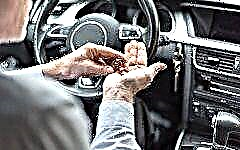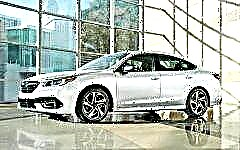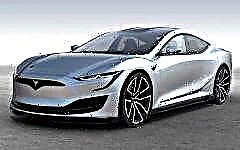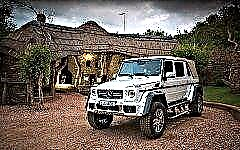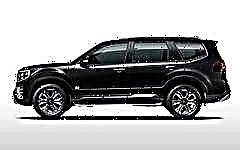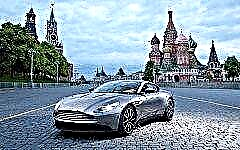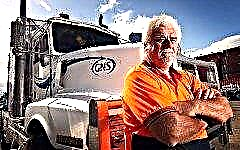

The content of the article:
- Polish drivers - interesting facts
Poland in 2019 continues to be popular among Russians as one of the "weekend" tourist destinations. Many people travel to Poland through the Kaliningrad region by car.
For Russian drivers, in addition to the traffic rules, insurances and fines of the neighboring country, it is often interesting to find out the distinctive features of Polish drivers so that they do not come “to a strange monastery” with their own charter.
Polish drivers - interesting facts
Fact 1
Highways in the city and its suburbs are most loaded on weekends and holidays - this is not surprising to the residents of Russian cities. But the most "black" Poles consider the first day of November, when the Feast of All Saints is celebrated.
On this day, all motorists, despite knowing what will happen next, go to visit the graves of relatives, provoking a collapse on the roads.
It is on All Saints Day, despite numerous admonitions by the traffic police to refuse personal transport for this time, Polish motorists bravely make their way through traffic jams, get into an accident, and, accordingly, provoke even more confusion on the roads. Therefore, according to statistics, November 1 is the most emergency day of the year.
Fact 2

Poland, despite its membership in the European Union, could not acquire roads of European quality for a long time. They are still far from ideal, although construction is in full swing.
Before the European Football Championship, there were virtually no fast and multi-lane motorways between major cities. Therefore, Polish drivers are accustomed to driving carefully, differing from Russians in politeness during the movement.
Of the unspoken rules of "good taste", the following are used by motorists in Poland:
- drivers of oncoming traffic blink their headlights - somewhere ahead there is a radar or a patrol;
- to ask the car in front to give way - they flash their headlights;
- gestures are actively used for communication. So, with the help of their hands they can show that they are giving way or they are grateful for being allowed to pass "out of turn";
- often thank and "smile" by flashing the alarm.
Fact 3

Polish drivers are accustomed to a long-standing corrupt system that has governed the life of generations of Poles. The valiant law enforcement officers on the roads cannot take bribes nowadays, since they were "surrounded" with cameras, including in official cars.
In principle, it became impossible to give a bribe. Passing exams for the right to drive a car therefore takes a long time. It turns out to pass successfully only from the third or fifth time.
Future drivers are deliberately dumped on trifles, because the payback of the work of instructors who cannot receive additional bribes is perfectly compensated by additional retakes and unscheduled lessons.
Fact 4

An attempt to eradicate corruption in Poland has led to the fact that all local drivers know that they should not even hint at a bribe to the guards of the law.
Severe punishments are provided for both police officers, who give reason to think that they are ready to "solve the problem" unofficially, and for drivers who in one way or another hint at the possibility of "agreeing on controversial issues."
Fact 5
Drivers of such a large city as Warsaw have to keep in mind the complex system of transport interchanges in the capital. The problem also lies in the fact that there are almost fifty stops in the city with the name Dw Wilenski, but they differ only in numbers, and can be arbitrarily scattered up to half a kilometer from a completely identical one in name.
The bus routes are designed in such a way that meeting the same name of stops three times during a trip is a completely ordinary thing. When drivers agree to cross in the city "along the way", it is better to focus on anything, but not on the names of the stops.
Fact 6

The friendliest drivers in Poland live in Krakow. Drivers are distinguished by their attentiveness, courtesy towards other road users, be they a neighbor on the stream or a pedestrian.
The most nervous drivers drive along the roads of Warsaw. Although, given the complex and confusing structure of interchanges and streets, they probably have reasons for concern.
Fact 7
Polish drivers meticulously observe prescribed traffic rules, no matter how strange they may seem from the outside:
- the dipped beam should always be turned on, even in the sunniest weather the rule is not accepted to be neglected;
- wherever the Polish driver travels - in the city or in the countryside - meeting the sign "teren zabudowany" (built-up area) means the need to immediately slow down to 50 km / h. Any three buildings next to the road have this designation. Therefore, it will not work to accelerate, no matter how much you want;
- a serious violation is the excess of the number of passengers in the passenger compartment. The penalty for such a violation is quite high, amounting to PLN 100;
- Changing the shoes of cars into studded tires in winter is prohibited, and the use of winter tires is voluntary and optional. If necessary, driving on a snow-covered track, the wheels are equipped with anti-slip chains for a while.
Fact 8

Polish drivers are accustomed to the fact that the observance of the correctness of the road traffic is constantly monitored, and the roads, regardless of the type of terrain, are crammed with radars and cameras:
- Installing a radar detector in a car is considered a serious crime.
- The number of police officers on the roads is impressive, but they especially take to the streets en masse on holidays and weekends.
- Highways equipped with checkpoints are often raided to identify drunk drivers. They stop all cars, without exception, and it is impossible to refuse a breath test under any pretext. Refusal is punishable by the most stringent methods.
- The police can patrol the streets in cars without any identifying symbols disguised as ordinary civilian vehicles. None of the Polish drivers know when they can run into "misdirected Cossacks", which makes them constantly observe the smallest nuances of the rules.
If a Pole sees that a car in front deliberately slows down, shifts or behaves in some strange way, provoking a prohibited maneuver, the first thing he thinks about is that a representative of the law is driving such a car.
- Stopping a car at the request of a police officer means the need to perform a certain algorithm of actions. It is necessary to stop on the side of the road, opening the window and putting your hands on the steering wheel.
Getting out of the car with documents at the ready or a frantic attempt to get them are considered extremely suspicious - these actions are performed only at the direction of a police officer.
Fact 9

Drivers in Poland know that summer is the best time to start repairing roads, so driving on them is difficult during warm periods. It is easier to stop using the car for a while and switch to public transport running on free dedicated lanes.
Fact 10

Photo: gas station in Poland
Polish drivers never wait at gas stations for specially trained personnel to come up to refuel and wipe the windows. Polish gas stations operate in self-service mode. Before filling the tank, you have to pay for the fuel.
Gasoline 92 does not exist at the gas station, but there are two versions of the AI-95: one contains lead, the second does not.
In addition, the driver has the right, in addition to filling the tank, to collect 20 liters of gasoline into the canister. Self-service systems often seem inconvenient to Russian drivers, but Poles are accustomed to refueling that way. Refueling is fully automated and equipped with clear indications of the sequence of actions.
To prevent customers from getting their hands dirty, gas stations have containers with disposable gloves that drivers wear when it comes to filling the tank with gas.
Considering that gas refueling of vehicles is very common in Poland, specialized refueling stations are just as common as ordinary ones. There are always recreation areas with cafes, shops and restaurants near gas stations.
The cost of fuel varies quite a lot depending on which road and in which city the gas station is located. The cost of gas is two times cheaper than the price of gasoline.
Fact 11
In Poland, drivers are used to reading road signs very carefully. To park your car, you must always look at what the signs warn about. There are parking lots that require pre-purchased special passes.
At the same time, traditional paid parking becomes free from 6 pm to 8 am, as well as throughout all weekends and holidays.
Parking in an unauthorized place costs a large fine. The police put a blocker on the wheels of the offending car, which can only be removed by paying a fine, after which instructions will be issued by phone on how to unblock the vehicle.
Fact 12
Drivers are required to constantly monitor weather fluctuations. When visibility on the road is less than 50 meters, drivers should use fog lights, which should be turned off immediately as soon as the weather changes for the better.
When overtaking other vehicles in poor visibility conditions, cars must accompany their movement with short sound signals.
Fact 13

New roads being built in Poland often get paid. Therefore, Polish drivers are getting used to paying the fare. The size of the board directly depends on the distance.
When entering the highway in a special machine, the driver receives a ticket, which is the main document for the calculation. If a ticket is lost, the driver will have to part with the maximum possible amount for a particular road, so Poles driving with such coupons have to be extremely careful and careful.
You can pay for travel on the highways in any way (cash or non-cash), and both national currency and euros and dollars are accepted. In whatever currency the driver pays for the ride, the change will still be issued in zlotys.
Fact 14
Drivers are accustomed to navigate the roads of Poland by numbers. The number corresponds to a track of a certain quality.
The worst quality is for roads marked with three-digit numbers. They often do not have an asphalt surface. Roads marked with two-digit numbers are always asphalted, the number of passing lanes is at least two.
Single-digit numbers are assigned to highways, and the letter "A" is always added to the number. Each class of roads, in addition to the "digital" designation of quality, has a corresponding letter:
- A - "freeway";
- S - express road;
- GP is the main road on which you can drive quickly;
- G is the main road
- Z - normal road;
- L - local road;
- D - access road.
Fact 15

Polish drivers are accustomed to not only following the rules, obeying police orders, observing the weather so as not to miss turning on / off the fog lights. In Poland, there are some rather strange signs, well known to Poles, but confusing all other drivers.
Seeing near the road an orange and black banner with two numerical values and an inscription "Czarny Punkt", Poles drive very carefully. This unusual road sign warns of a dangerous section of the road, and the numbers written on it indicate how many people died and how many were injured along that section of the road.
So that the numbers do not change at their expense, the Poles prefer to observe all possible precautions.
Conclusion
Most of the Polish drivers are calm and patient, because there are many traffic lights in the country, it takes a long time to wait for them to switch the signal, and speed limits are set over short distances. At the same time, all Poles are very lenient about the seeming oddities of the traffic, but at the same time they do not like cars with non-Polish numbers and when someone does not like something in their home country.

